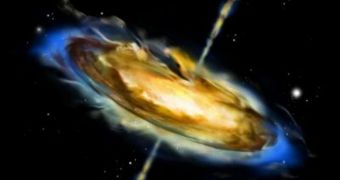By utilizing one of the most advanced interferometry instruments in the world, named AMBER, a team of astronomers was recently able to observe the active accretion phase of a supermassive black hole.
What this means is that they were able to see the dark behemoth as it was gorging itself on matter accumulated in its accretion disk. The latter is a structure where materials attracted from around the black hole are stored before they stream through the object's event horizon.
Due to the extreme acceleration and friction that matter undergoes in this disk, it is heated up to temperatures reaching millions of degrees, which causes them to start emitting radiations and light.
Astronomers wanted to image the accretion disk around the supermassive black hole at the core of the galaxy NGC 3783. This formation has an active galactic nucleus (AGN), which is an actively feeding black hole.
The problem is that the experts were unable to achieve the necessary angular resolution to image the entire disk with any singular telescope. They then decided to turn to the European Southern Observatory (ESO) for help. The organization operates a massive telescope in the Chilean Andeas.
The Very Large Telescope Interferometer (VLTI) is located at Paranal Observatory, and is made up of four, interlinked telescopes. By using AMBER, the experts were able to combine the light collected by three of four VLTI telescopes into a single, high angular resolution image.
By using interferometry, the three instruments behaved as a single telescope with a 130-meter (426-foot) diameter. The target AGN is located several tens of millions of light-years away.
“This three-telescope interferometry is a major milestone toward directly imaging the growth phase of supermassive black holes,” University of California in Santa Barbara (UCSB) Department of Physics postdoctoral researcher, Sebastian Hoenig, explains.
He was one of the astrophysicists in the research team. The group was coordinated by the director of the Max Planck Institute for Radio Astronomy (MPIfR) in Bonn, Germany, Gerd Weigelt, EurekAlert reports.
“The ESO VLTI provides us with a unique opportunity to improve our understanding of active galactic nuclei. It allows us to study fascinating physical processes with unprecedented resolution over a wide range of infrared wavelengths. This is needed to derive physical properties of these sources,” Weigelt says.

 14 DAY TRIAL //
14 DAY TRIAL //